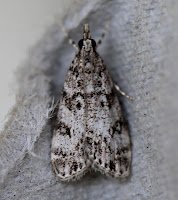 |
| Shaded Broad-bar (Scotopteryx chenopodiata) |
We had a great catch last night that included four new
species. This brings our current count to 208. I’m not sure what made the
difference… could it have been the lack of rain for once? Perhaps we simply did
a better job of opening the trap carefully so we wouldn’t lose the energetic
flyers.
The first one to fly out was the Shaded Broad-bar (Scotopteryx chenopodiata). It was so
elegant and impressive that we instantly recognized it as a new species. Skotos
(darkness) and pterux (a wing) refer to the markings on the
forewings, just as the case with its English name. Its larvae feed on clover
which is abundant in the grasses of Shandy Hall. When I return home to America
I’ll need to explain to all the pesticide-happy homeowners why they need to let
the clover thrive in their “perfect” crabgrass and clover-free lawns. Save the
Shaded Broad-bar!
 |
| Metzneria metzneriella |
 |
| Eudonia truncicolella |
 |
| Scoparia ambigualis |
The next two moths looked similar at first glance but I was delighted
to find out that they were two separate new species. The Scoparia ambigualis
was found first. It’s name comes from scopae (twigs or a besom) because
its namers thought it resembled the bottom of a broom (and in one case, the end
of a paintbrush). You can probably guess ambiguous came from the
difficulty in differentiating it from other species, much like I initially did
this morning.
The other moth, also black and white, looks to be the Eudonia
truncicolella. It’s name comes from heudo (to rest), trunucus (tree
trunk), and colo (to inhabit) from the moth’s habit of resting on tree
trunks during the day. This information strengthens the similarity between the
two species because the Scoparia ambigualis is also often found resting
on rocks and tree trunks by day.
We had some other beautiful varieties that warrant a photograph, even
if they are not new. The July Highflyer (Hydriomena furcata: hudria + meno means
‘to remain in a water-pot', furca is a two-pronged fork which describes its wings’ markings) had incredible shades of green and purplish grey. The Bird-Cherry
Ermine (Yponomeuta evonymella) glimmered in the sun with its sleek,
dalmatian-like coat. Its name comes from huponomeuo (to make underground
mines) because its labial palpus resembles a miner’s pickaxe. Evonymella
derives from Euonymus, the genus of the spindle tree that was incorrectly assumed to be its
larvae’s foodplant.
 |
| July Highflyer (Hydriomena furcata) |
 |
| Bird-Cherry Ermine (Yponomeuta evonymella) |
Before I go, I’d like to share an article from last month’s Nature
Studies section of the Independent that I came across today: Michael McCarthy’s
Moths are just as worthy of our wonder as butterflies. It’s a great read
for any moth enthusiast and the print version features an illustration of the
Bird-Cherry Ermine who we’ve just photographed today (see above).
Post by Helen Levins
